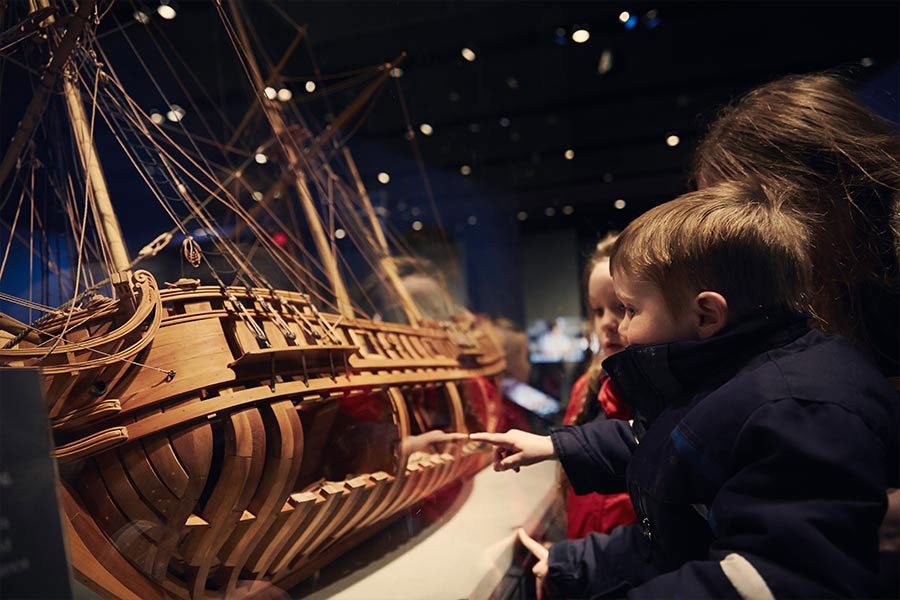La Belle Artifacts Rolling into Austin July 17
Arrival of 325-year-old keel the start of famed ship's final journey
On Thursday, July 17, 2014, a 325-year-old piece of Texas history is scheduled to arrive at the Bullock Texas State History Museum. The keel of the historic ship, La Belle, along with the keelson, a portion of the mast and numerous hull timbers, will be transported that day from the Riverside Campus of Texas A&M University under the direction of conservator Peter Fix of the university's Center for Maritime Archaeology and Conservation. Transportation of the timbers requires intricate handling that will be orchestrated by John Clegg of Clegg Industries of Victoria, Texas, who has been a volunteer involved with the La Belle project since it began. La Belle sank off the coast of Texas in Matagorda Bay in 1686 and was excavated by the Texas Historical Commission in 1996 in one of the most extraordinary engineering feats ever associated with an archaeological excavation. The nine-month, multi-million-dollar excavation yielded more than one million artifacts and the main timbers of the ship. Those timbers, select artifacts, photographs, maps and more will be part of an exhibit opening October 25, 2014 at the Bullock Museum. As part of the exhibit, Fix and a team of conservators will reassemble the hull in front of visitors in the gallery.
La Belle Artifact Arrival Event
What: Arrival of the largest portions of the historic La Belle ship, including the 800-pound keel, the 1,100-pound keelson and assorted timbers, including the forefoot, rising wood, deadwood, sternpost, stem, 20+ floors, 40 first futtocks, 20 plus second futtocks, 25 third futtocks, keelson riders, buttresses and the mast.
Who: Peter D. Fix, assistant director, Center for Maritime Archaeology and Conservation Conservator and Head of Reconstruction for La Belle; project volunteer John Clegg, Clegg Industries, Inc.; and other project representatives from the Bullock Museum, the Texas Historical Commission, and Texas A&M University.
When: 2 p.m. on Thursday, July 17, 2014
Where: Bullock Texas State History Museum - Meet at Information Desk on First Floor
1800 N. Congress Avenue, Austin, Texas
About the Exhibit
One of the most important shipwreck discoveries in North America, La Belle has risen after 300 years at sea to tell a captivating story filled with piracy, murder and miscalculation that doomed the 17th-century voyage and changed the course of history in Texas forever. A new exhibit, La Belle: The Ship That Changed History, opens at the Bullock Texas State History Museum on October 25, 2014 to reveal this intriguing Texas story.
Follow the incredible journey of La Belle from 1684 when it set sail from France under the aegis of King Louis XIV and explorer Rene-Robert Cavelier, Sieur de la Salle, to its demise in Texas's Matagorda Bay two years later. Experience its archeological resurrection in the 1990s and subsequent preservation that continues this fall with the live-action reassembly of the original ship's hull in full view of visitors at the Bullock Museum in Austin.
La Belle: The Ship That Changed History is organized by the Bullock Texas State History Museum and guest curated by Jim Bruseth, former director of the Archeology Division of the Texas Historical Commission, which sponsored the ship's excavation. Partners include the Texas Historical Commission, Texas A&M University's Conservation Research Laboratory and the Musée National de la Marine. Project support provided by the State of Texas, the National Endowment for the Humanities and the Institute for Museum and Library Services and the Texas State History Museum Foundation. Visit TheStoryofTexas.com or call (512) 936-4649 for more information.
Downloads
Media Contact
| General Inquiries | |
|---|---|
| 512-463-5424 | |
